
Concept explainers
(a)
Interpretation:
The IUPAC name for the given compound is to be determined.
Concept introduction:
In case of molecules containing a
If the root is a chain, numbering begins from that end of the chain which encounters the
The carbon atoms having a double or triple bond between them are always assigned C1 and C2, if the root is a ring. This must be done such that the locator numbers for the substituents are minimized. The lower of the two locator numbers for the
Answer to Problem B.23P
The IUPAC name for the given compound is:
Explanation of Solution
The given molecule is:

In this molecule, the largest carbon ring containing the double bond has six carbon atoms. Hence, the root is cyclohexene. The ring is numbered such that the double bonded carbon atoms get C1 and C2 as the locator numbers.
The numbering system is shown below:
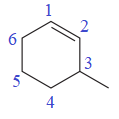
One methyl group is attached at the C3 carbon atom of the ring.
Thus, the IUPAC name of the compound is:
The IUPAC name of the compound is written according to the rules for nomenclature.
(b)
Interpretation:
The IUPAC name for the given compound is to be determined.
Concept introduction:
In case of molecules containing a
If the root is a chain, numbering begins from that end of the chain which encounters the
The carbon atoms having a double or triple bond between them are always assigned C1 and C2, if the root is a ring. This must be done such that the locator numbers for the substituents are minimized. The lower of the two locator numbers for the
Answer to Problem B.23P
The IUPAC name for the given compound is:
Explanation of Solution
The given compound is:

In this molecule, the largest carbon ring containing the double bond has four carbon atoms. Hence, the root is cyclobutene. The ring is numbered such that the double bonded carbon atoms get C1 and C2 as the locator numbers.
The numbering system is shown below:
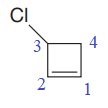
One chlorine atom is attached as a substituent on the C3 carbon atom of the ring.
Thus, the IUPAC name of the compound is:
The IUPAC name of the compound is written according to the rules for nomenclature.
(c)
Interpretation:
The IUPAC name for the given compound is to be determined.
Concept introduction:
In case of molecules containing a
If the root is a chain, numbering begins from that end of the chain which encounters the
The carbon atoms having a double or triple bond between them are always assigned C1 and C2, if the root is a ring. This must be done such that the locator numbers for the substituents are minimized. The lower of the two locator numbers for the
Answer to Problem B.23P
The IUPAC name for the given compound is:
Explanation of Solution
The given molecule is:
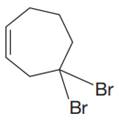
In this molecule, the largest carbon ring containing the double bond has seven carbon atoms. Hence, the root is cycloheptene. The ring is numbered such that the double bonded carbon atoms get C1 and C2 as the locator numbers.
The numbering system is shown below:
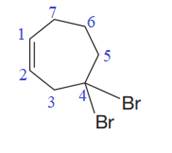
Two bromine atoms are attached to the C4 carbon atom of the ring. Thus, a prefix ‘di’ must be used to indicate the number of bromide substituents.
Thus, the IUPAC name of the compound is:
The IUPAC name of the compound is written according to the rules for nomenclature.
(d)
Interpretation:
The IUPAC name for the given compound is to be determined.
Concept introduction:
In case of molecules containing a
If the root is a chain, numbering begins from that end of the chain which encounters the
The carbon atoms having a double or triple bond between them are always assigned C1 and C2, if the root is a ring. This must be done such that the locator numbers for the substituents are minimized. The lower of the two locator numbers for the
Answer to Problem B.23P
The IUPAC name for the given compound is
Explanation of Solution
The given molecule is:
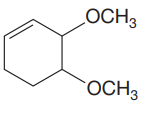
In this molecule, the largest carbon ring containing the double bond has six carbon atoms. Hence, the root is cyclohexene. The ring is numbered such that the double bonded carbon atoms get C1 and C2 as the locator numbers.
The numbering system is shown below:
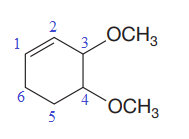
At C3 and C4 carbon atoms of the ring, two methoxy substituents are attached.
Thus, a prefix ‘di’ must be used for methoxy substituents to indicate their number.
Thus, the IUPAC name of the compound is
The IUPAC name of the compound is written according to the rules for nomenclature.
(e)
Interpretation:
The IUPAC name for the given compound is to be determined.
Concept introduction:
In case of molecules containing a
If the root is a chain, numbering begins from that end of the chain which encounters the
The carbon atoms having a double or triple bond between them are always assigned C1 and C2, if the root is a ring. This must be done such that the locator numbers for the substituents are minimized. The lower of the two locator numbers for the
Answer to Problem B.23P
The IUPAC name for the given compound is
Explanation of Solution
The given molecule is:
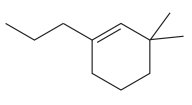
In this molecule, the largest carbon ring containing the double bond has six carbon atoms. Hence, the root is cyclohexene. The ring is numbered such that the double bonded carbon atoms get C1 and C2 as the locator numbers.
The numbering system is shown below:
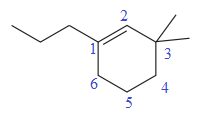
At C1 carbon atom of the ring, a substituent propyl is attached. At C3 carbon atom of the ring, two methyl groups are attached. Thus, a prefix ‘di’ must be used for methyl substituents to indicate the number. Out of propyl and methyl substituents, methyl comes first alphabetically, hence it will be written first in the name.
Thus, the IUPAC name of the compound is
The IUPAC name of the compound is written according to the rules for nomenclature.
(f)
Interpretation:
The IUPAC name for the given compound is to be determined.
Concept introduction:
In case of molecules containing a
If the root is a chain, numbering begins from that end of the chain which encounters the
The carbon atoms having a double or triple bond between them are always assigned C1 and C2, if the root is a ring. This must be done such that the locator numbers for the substituents are minimized. The lower of the two locator numbers for the
Answer to Problem B.23P
The IUPAC name for the given compound is
Explanation of Solution
The given molecule is:
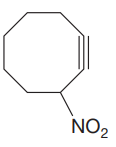
In this molecule, the largest carbon ring containing the triple bond has eight carbon atoms. Hence, the root is cyclooctayne. The ring is numbered such that the double bonded carbon atoms get C1 and C2 as the locator numbers.
The numbering system is shown below:
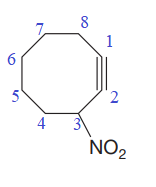
At C3 carbon atom of the ring, a substituent nitro is attached.
Thus, the IUPAC name of the compound is
The IUPAC name of the compound is written according to the rules for nomenclature.
Want to see more full solutions like this?
Chapter B Solutions
ORGANIC CHEMISTRY PRINCIPLES & MECHANISM
- In the following reaction, what quantity in moles of CH₃OH are required to give off 4111 kJ of heat? 2 CH₃OH (l) + 3 O₂ (g) → 2 CO₂ (g) + 4 H₂O(g) ∆H° = -1280. kJarrow_forwardIndicate the processes in the dismutation of Cu2O.arrow_forward1. Consider these three reactions as the elementary steps in the mechanism for a chemical reaction. 2600 2400 2200 2000 1800 1600 1400 1200 1000 800 Potential Energy (kJ) 600 400 200 0 -200- -400 -600- -800 (i) Cl₂ (g) + Pt(s) → 2Cl (g) + Pt(s) (ii) Cl (g)+ CO (g) + Pt (s) → CICO (g) + Pt (s) Ea = 1550 kJ Ea = 2240 kJ (iii) Cl (g) + CICO (g) → Cl₂CO (g) Ea = 2350 kJ AH=-950 kJ ΔΗ = 575 ΚΙ AH=-825 kJ a. Draw the potential energy diagram for the reaction. Label the data points for clarity. The potential energy of the reactants is 600 kJ Reaction Progress b. What is the overall chemical equation? c. What is the overall change in enthalpy for the above chemical reaction? d. What is the overall amount of activation energy for the above chemical reaction? e. Which reaction intermediate would be considered a catalyst (if any) and why? f. If you were to add 2700kJ of energy to the reaction (e.g. 2700 kl of heat or electricity), would you be able to make the reaction reverse itself (i.e. have…arrow_forward
- draw the enolate anion and the carbonyl that would be needed to make this product through an aldol addition reaction.arrow_forwardDraw the Michael Adduct and the final product of the Robinson annulation reaction. Ignore inorganic byproducts.arrow_forwardDraw the Michael adduct and final product of the Robinson annulation reaction. Ignore inorganic byproductsarrow_forward
- Post Lab Questions. 1) Draw the mechanism of your Diels-Alder cycloaddition. 2) Only one isomer of product is formed in the Diels-Alder cycloaddition. Why? 3) Imagine that you used isoprene as diene - in that case you don't have to worry about assigning endo vs exo. Draw the "endo" and "exo" products of the Diels-Alder reaction between isoprene and maleic anhydride, and explain why the distinction is irrelevant here. 4) This does not hold for other dienes. Draw the exo and endo products of the reaction of cyclohexadiene with maleic anhydride. Make sure you label your answers properly as endo or exo. 100 °C Xylenes ??? 5) Calculate the process mass intensity for your specific reaction (make sure to use your actual amounts of reagent).arrow_forwardIndicate the product(s) A, B C and D that are formed in the reaction: H + NH-NH-CH [A+B] [C+D] hydrazonesarrow_forwardHow can you prepare a 6 mL solution of 6% H2O2, if we have a bottle of 30% H2O2?arrow_forward
- How many mL of H2O2 from the 30% bottle must be collected to prepare 6 mL of 6% H2O2.arrow_forwardIndicate the product(s) B and C that are formed in the reaction: HN' OCH HC1 B + mayoritario C minoritario OCH3arrow_forwardIndicate the product(s) that are formed in the reaction: NH-NH, OCH3 -H₂O OCH3arrow_forward
 Principles of Modern ChemistryChemistryISBN:9781305079113Author:David W. Oxtoby, H. Pat Gillis, Laurie J. ButlerPublisher:Cengage Learning
Principles of Modern ChemistryChemistryISBN:9781305079113Author:David W. Oxtoby, H. Pat Gillis, Laurie J. ButlerPublisher:Cengage Learning
